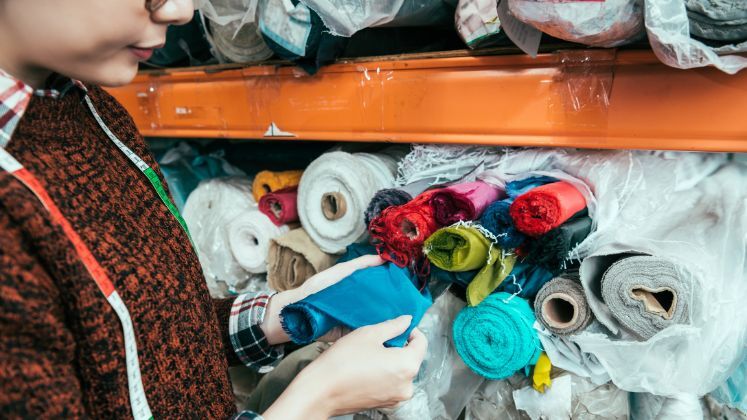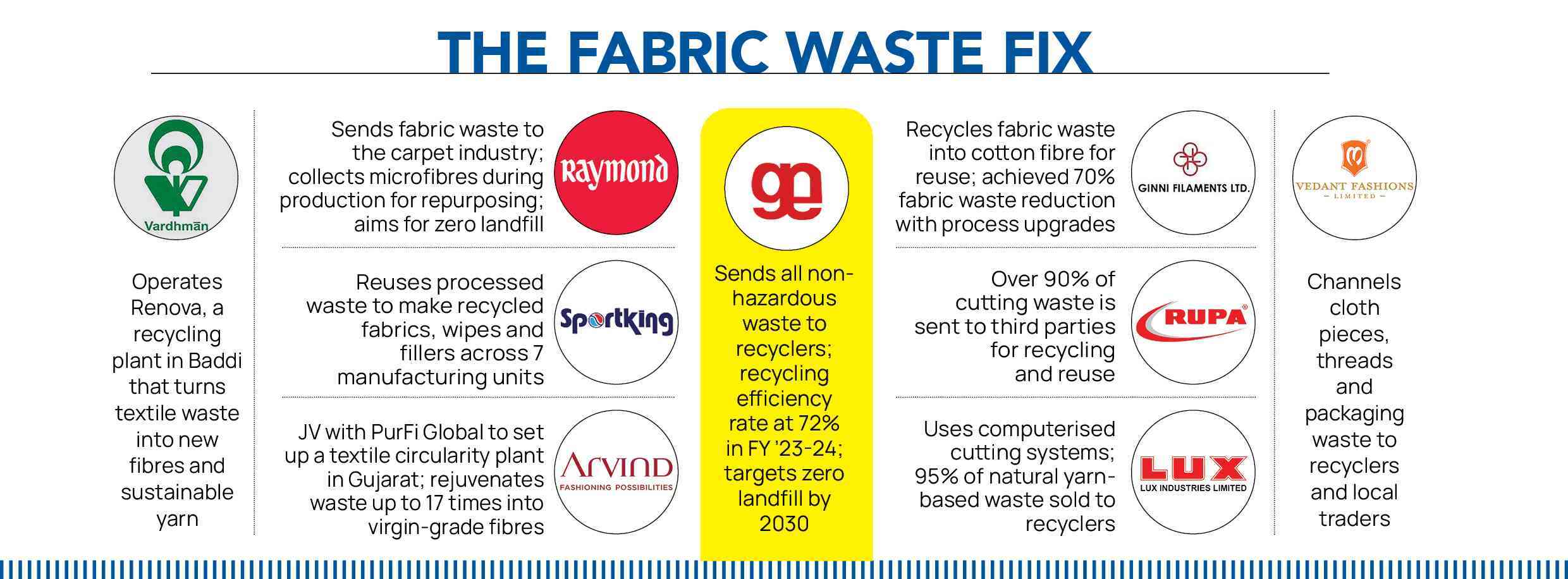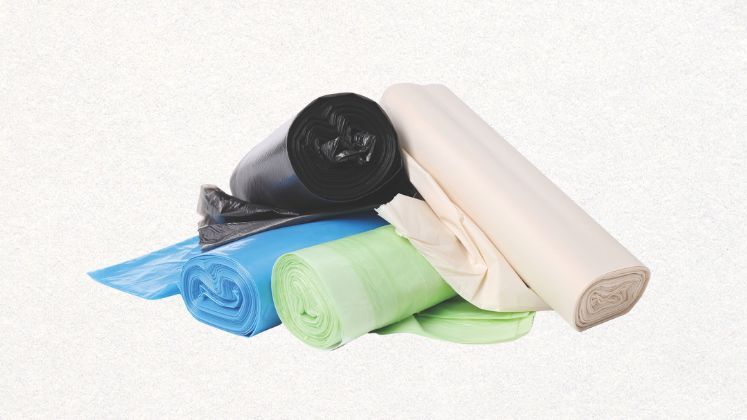Fabric waste is the elephant in the cutting room and manufacturers can’t ignore it any longer. The crisis doesn’t begin at landfills; it starts on the factory floor. Pre-consumer waste like offcuts, chindi (scraps), selvages and sewing-floor discards are quietly eating into margins and sustainability goals.
According to Fashion For Good, India generates 7,800 kilotonnes of textile waste every year—42% of it comes from pre-consumer sources. Within this, garment manufacturing is a major contributor, responsible for 24% of the total waste.
Despite growing conversation around sustainable production, the garment industry continues to generate massive volumes of fabric waste that cannot be reused or repuposed— only recycled.
A major contributor to irrecoverable waste is the cutting department, where low marker efficiency, excess lay widths and poor alignment produce oddly shaped offcuts. These scraps are too irregular or small to be used in any conventional garment construction. Even with CAD and auto-cutting systems, a cutting wastage of 10% is common and once the fabric is cut inefficiently or misaligned, it becomes impossible to reintroduce into production. Sewing-floor rejections form another significant waste stream.
Stitching errors, seam puckering, incorrect assembly and poor workmanship can render entire panels unusable. Sometimes, small garment components like pocket flaps, collars, cuffs or piping strips are cut separately. If quality issues like fraying, misalignment or notches occur, these small pieces are rejected. Due to their size and custom nature, they cannot be reused in another style or batch and therefore enter the chindi waste stream.
In styles involving surface ornamentation like embroidery, laser cuts, appliqués or smocking, fabric is often trimmed after the decorative work is done to give shape. These trimmings are typically small and highly customised — for instance, circular or floral cutouts from a front panel. Once trimmed, the leftover is unusable, resulting in unrecoverable chindi waste.
Production lines frequently take small swatches for testing GSM, shrinkage, colour fastness or needle calibration. Over a bulk order, these test cuts accumulate as a pile of small, random-sized fabric pieces that serve no further purpose. Since they come from various rolls and dye lots, even patching them together isn’t viable.
After bulk cutting, panels are sorted and bundled. Occasionally, some pieces are mismatched, mislabelled or left over due to batch miscounts. These orphaned parts, if not used in size top-ups, remain in storage for months before being discarded — most often as chindi because they are partial components, not whole panels.
During final inspection, certain garments may require small trims or corrections — such as neatening a hemline, trimming a loose edge or removing excess interfacing. These finishing touches generate micro-fabric shreds and narrow edge pieces that are tossed aside. Since they’ve passed through multiple processes (sewing, pressing, tagging), these scraps often include threads, paper tags or glue — making them non-reusable in any clean textile workflow.
To tackle this growing problem, manufacturers are finding creative and practical ways to deal with fabric waste such as turning scraps into yarn, upcycling leftovers into new products, passing unusable pieces to other industries like carpets or cleaning wipes, adopting smarter cutting technologies and teaming up with tech innovators to build more circular systems.
Turning Scraps into Solutions
For instance, Vardhman, with a turnover of over US $ billion and an annual capacity of 1.8 million shirts, is reusing materials through its Renova recycling plant in Baddi, Himachal Pradesh. This facility converts textile waste into new fibres, which are then used to create new clothes or other textile products. The plant has a production capacity of 6 TPD for producing sustainable recycled yarn. Raymond Ltd., with a revenue of Rs. 9,286 crore (US $ 1.09 billion) and a garment output of 9 million pieces annually, channels fabric waste from its Vapi facility to the carpet industry, giving the material a second life.
To minimise microfibre shedding, the company has also established a system to collect fibres and microfibres released during production. These fibres are repurposed into yarn, fabric or other fibre-based products through third-party partners. Raymond has set a goal of achieving Zero Waste to Landfill by 2030.
Another vertically integrated manufacturer, Sportking India, uses its processed waste to create new products including recycled fabric, cleaning wipes and fillers. With seven manufacturing facilities across Punjab and Himachal Pradesh, the company reports an annual turnover of over Rs. 1,500 crore (US $ 210 million), with more than half of its revenue coming from exports to over 30 countries.
Some manufacturers are also joining hands with solution providers to tackle textile waste at scale. For example, Arvind Ltd., a vertically integrated manufacturer with a revenue of Rs. 8,329 crore (US $ 975.2 million) and an annual capacity exceeding 56 million pieces, has partnered with sustainable technology company PurFi Global LLC to tackle textile waste.
Through their joint venture, PurFi Arvind Manufacturing India (PAMI), the partners are setting up a textile circularity facility in Gujarat, where 10 production lines will be activated over the next four years. PAMI will initially process white cotton, coloured cotton, denim and synthetics— sourced primarily from Arvind’s own manufacturing units—into fibres.
The facility will launch operations with a capacity of 3,500 metric tonnes, supplemented by a secondary line of 5,500 tonnes annually. According to Arvind, using PurFi’s proprietary technology, the plant can rejuvenate textile waste into high-quality fibres—not just once, but up to 17 times, offering a scalable alternative to the traditional ‘one-and-done’ recycling model.
The facility also has the potential to expand to 10 large production lines within the next three years to meet rising demand from global brands and retailers.
Others are partnering with recyclers to manage different types of waste. For instance, Vedant Fashions Ltd., which has a revenue of Rs. 1,367.5 crore (US $ 160.88 million) and is known for ethnic brands such as Manyavar, Mohey, Mebaz, Manthan and Twamev, channels different waste streams like cloth pieces, threads and paper through recyclers and local traders for disposal.
Likewise, Gokaldas Exports sent all non-hazardous solid wastes like paper, plastic, cut fabric wastes and metal to authorised recyclers. In FY 2022–23, the company generated 4,295 metric tonnes of fabric waste, trims waste and packaging material. This increased to 4,998 metric tonnes in FY 2023–24. Despite this increase, recycling efforts improved, with 3,612 metric tonnes recycled in FY 2023–24, up from 3,557 metric tonnes the previous year—achieving a recycling efficiency of 72%. Gokaldas, which reported a revenue of Rs. 2,409 crore (US $ 283.4 million) in FY 2023–24, is targeting zero solid waste-to-landfill by 2030. Rupa & Co. Ltd., with a daily production capacity of over 7,00,000 pieces and revenue of Rs. 1,217 crore (US $ 143.18 million) in FY 2023–24, also channels its waste cutting fabrics to third parties for recycling. As a result, more than 90% of its production waste is reused in some form. Similarly, Ginni Filaments, with an annual production capacity of 10 million garments, sends fabric waste from its operations to recyclers who convert it into recycled cotton fibres that can be reused in manufacturing processes. Lux Industries, with a turnover of Rs. 2,470 crore (US $ 290.59 million) in 2024 and a daily production capacity of 1.2 million garments, primarily generates waste cloth cuttings made from natural yarn. Around 95% of this recyclable waste is sold to recyclers, who repurpose it for use in other industries.
Smart Machines, Less Waste
Garment manufacturers are leveraging automation and smart machines to cut down fabric waste and improve production efficiency. Technologies like auto-cutting, laser and water-jet cutters enable precise, layered fabric cutting that minimises offcuts. Meanwhile, robotic and computer-controlled sewing systems streamline stitching, reduce errors and optimise material usage. Take Lux Industries, for example. Its Dankuni plant in West Bengal is equipped with hi-tech machinery from brands like Morgan Tecnica, Mayer & Cie, Bierrebi, Hi-tech Fabric Inspection Machines, Eastman Machineries, Siruba, Juki and Brothers. According to the company, the use of computerised cutting systems significantly lowers fabric waste during the knitting and cutting stages. Ginni Filaments has also adopted targeted interventions to reduce waste. It has installed a Card Web Reducer in its card machine to reduce fabric width before production. This initiative helped avoid 81.3 tonnes of fabric waste recycling in 2022–23 and 74.2 tonnes in 2023–24. The company has achieved a 70% reduction in fabric waste through advancements in process technology. Its garment production facility in Noida uses automatic cutting with the GERBER cutting room solution, which includes CAD, automatic spreading and automatic cutting systems. Sewing machines from JUKI, PEGASUS and YAMATO are also used to ensure precision, consistency and less wastage in production.
To optimise fabric handling and cutting processes, Gokaldas Exports has implemented a barcoding system for incoming materials like fabric rolls and trims/accessories to ensure traceability. Its warehouse management system incorporates digital width checking, shade identification using QR labels and shrinkage assessment via camera vision powered by AI. The company also uses a fabric optimisation plan and tracks the usage of end bits to reduce wastage. Online traceability tools help monitor spreading and cutting room efficiency. A centralised CADD system supports automated marker making with a nesting engine incorporating the cut plan.










